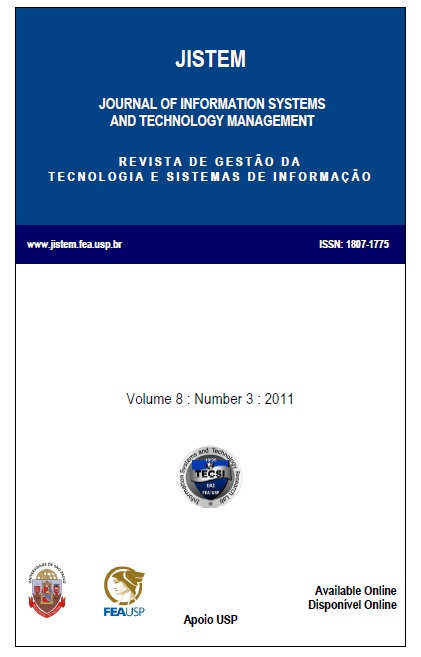Managing it as a business: the Lutchen's gap in the 100 top organizations based in Brazil
DOI:
https://doi.org/10.4301/S1807-17752011000300010Keywords:
IT Strategy, Innovation, IT as business, Lutchen GapAbstract
A common problem in IT management involves the lack of business vision on the part of IT executives who align IT to the strategic assumptions of the company, but forget the tactical functions of the former, managed as a business. This is known as the Lutchen's gap. Because of its importance in the context of IT management, this paper is a complementary approach to the preceding one from Rodrigues et al. (2009) and aims at identifying the Lutchen´s gap presence in the management of IT among the 100 top companies located in Brazil. To do this, we proceeded to a description of the profile of IT management in these companies, controlled by the executive board. We used a questionnaire filled out by IT executives, containing 77 questions covering the four functions of IT in a company. The main results indicate that: (a) In the IT's Alignment function, the design of IT reveals dichotomies between business and IT objectives (b) In the IT's Management function, the IT's budget is oriented toward ensuring "delivering" abilities to IT services and differing in the methods of cost control, ranging from apportion by volume, overheads and by ABC cost, (c) in the IT's Deliver function, evidence suggests that IT is managed as a business enabler; and (d) in the IT's Quality and Safety Assurance, IT executives monitor quality and safety events, but are limited to IT's basic operations. In conclusion, in the companies surveyed, IT is seen much more as an" on-demand solution provider", rather than as an instrument of innovation and competitiveness enabler for organizations.Downloads
Download data is not yet available.
Downloads
Published
2011-12-01
Issue
Section
nd2017783415
How to Cite
Managing it as a business: the Lutchen’s gap in the 100 top organizations based in Brazil . (2011). Journal of Information Systems and Technology Management, 8(3), 717-748. https://doi.org/10.4301/S1807-17752011000300010



